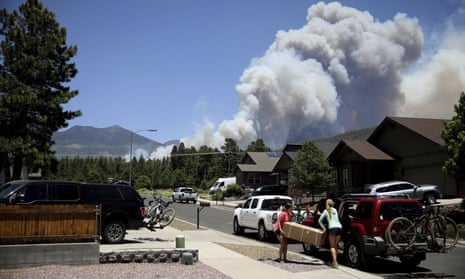Fueled by gusty winds through drought-stricken remote terrain, wildfires burning north of Flagstaff, Arizona, exploded in size on Monday, with officials estimating more than 24,000 acres (9,700 hectares) had been blackened by Tuesday morning.
Fire crews battling the blaze have faced intense conditions that have caused extreme fire behavior and sent enormous smoke plumes swirling into the sky.
“Due to high winds, really no air assets could fly safely,” said Aaron Graeser, incident commander, speaking at news briefing on Monday night. “We don’t count on air assets to be successful, there are always people on the ground regardless. However, it can certainly buy us some tactical and operational advantage when we have it.”
By Tuesday, the winds had calmed and aircraft were again in motion, offering hope that progress could be made on the fire while conditions were more favorable.
But the largest fire, known as the Pipeline fire, which ignited on Sunday, and two smaller fires that started nearby on Monday and then conjoined, are still at 0% containment. Graeser said evacuations and structure protection were the top priorities for the roughly 600 firefighters on the ground. About 2,500 homes have been evacuated and two structures have burned, the Coconino county sheriff’s office said.
“On a day like today, with winds doing what they were doing, with the fuel conditions we have,” Graeser said, “the No 1 value at risk is the public that we serve.”
My wife @andreackelly is a great photographer and shot this nightmare coiling in the sky. pic.twitter.com/2pdX48V09n
— Michel Marizco (@MichelMarizco) June 13, 2022
The blaze was also pushing into Coconino Peaks wilderness area and tribal lands and cultural sites to the north, Graeser said.
Residents around the city looked toward the mountains as smoke billowed through the air and winds howled, some scared, some nervous most hoping that moisture in the forecast later this week brings some relief.

“We’re most definitely dry,” said Flagstaff resident Colin Challifour late on Monday. “The forests are dry. It’s unfortunate. You don’t like to see it.”
The strong winds also swept smoke into the sky, creating unhealthy air quality across the region, even reaching into Colorado and other surrounding areas. “While winds will be weaker today compared to yesterday, still expecting gusty south-west winds which will continue to result in active fire behavior and increased smoke production,” the Arizona department of environmental quality said in an update on Tuesday morning, cautioning residents to stay inside, close windows and use air filtration systems if possible.
The climate crisis has set the stage for increasing wildfire intensity, delivering hotter temperatures that bake moisture out of parched landscapes. Wildfires broke out early this spring in multiple states in the western US, where the climate crisis and an enduring drought are fanning the frequency and intensity of forest and grassland fires.
Views from the O'Leary Webcam at 360 Overwatch tonight at 8:28 p.m. give us an idea of just how far this fire has spread... from the peak to the valley below. The views we're accustomed to will be black come morning. This is why we obey burn bans! #PipelineFire #azwx pic.twitter.com/YRhcKbajpM
— NWS Flagstaff (@NWSFlagstaff) June 14, 2022
The number of square miles burned so far this year is more than double the 10-year national average, and states like New Mexico have already set records with devastating blazes that destroyed hundreds of homes while causing environmental damage that is expected to affect water supplies.
Nationally, more than 6,200 wildland firefighters are battling nearly three dozen uncontained fires that had charred more than 1m acres (405,000 hectares), according to the National Interagency Fire Center.
Even in Alaska, forecasters have warned that many fires in the state’s south have grown exceptionally over the last week, which is unusual. South-west Alaska normally experiences shorter periods of high fire danger because intermittent rain can provide relief, but since mid-May the region has been hot and windy, drying out vegetation.
Favorable weather on Monday helped slow the progression of a tundra wildfire roughly three miles (4.8km) away from a Yup’ik village. Moderate temperatures and a shift in the wind that had been driving the fire toward St Mary’s will allow firefighters to directly attack the flames and increase protections for the community.
In California, evacuations were ordered for about 300 remote homes near a wildfire that flared up over the weekend in forest land north-east of Los Angeles near the Pacific Crest trail in the San Gabriel mountains. It had scorched about 990 acres (400 hectares) of pine trees and dry brush as of Monday and was 27% contained, said fire spokesperson Dana Dierkes.
A second fire in Tehama county in northern California had destroyed 10 buildings, damaged four others and threatened about 160 structures, fire officials said. It was 30% contained as of Tuesday afternoon.
A springtime fire outside Flagstaff, named the Tunnel fire, destroyed more than two dozen homes before it was contained earlier this month. Many residents who evacuated then have been forced to leave their homes a second time, barely given enough time to settle back in before the onslaught of a new blaze.
The causes of the latest California fires were under investigation.
Lightning is suspected in one of the northern Arizona fires, but authorities don’t yet know what caused the larger wildfire.
With nearly no precipitation last month, Arizona marked one of its driest Mays on record, according to the state’s department of water resources. High fire risks are expected to continue until the south-west monsoon, which typically delivers rain through the late summer months, offers a reprieve. Until then, residents remain on alert while officials work to contain the conflagrations currently burning.
“I know coming off the Tunnel fire and the impacts of that, this was unwelcome,” Graeser said. “However, please rest assured that there are lots of men and women out there standing guard tonight and will continue to protect this community.”
Associated Press contributed reporting
